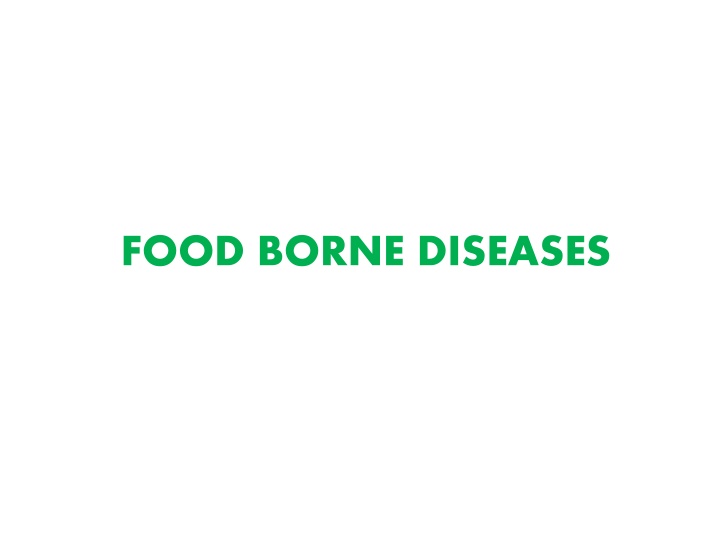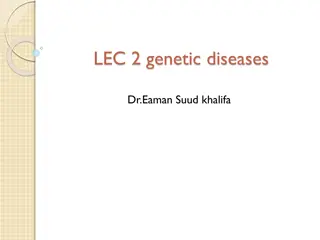
Food-Borne Diseases and Salmonellosis
Explore the classification of food-borne diseases, including infections and intoxications. Learn about salmonellosis, caused by Salmonellae organisms present in contaminated food, leading to infections in humans. Discover common bacterial, viral, and fungal food-borne infections and their symptoms. Stay informed to prevent food poisoning and promote food safety.
Download Presentation

Please find below an Image/Link to download the presentation.
The content on the website is provided AS IS for your information and personal use only. It may not be sold, licensed, or shared on other websites without obtaining consent from the author. If you encounter any issues during the download, it is possible that the publisher has removed the file from their server.
You are allowed to download the files provided on this website for personal or commercial use, subject to the condition that they are used lawfully. All files are the property of their respective owners.
The content on the website is provided AS IS for your information and personal use only. It may not be sold, licensed, or shared on other websites without obtaining consent from the author.
E N D
Presentation Transcript
Food borne diseases Food borne diseases (FBD) are acute illnesses associated with the recent consumption of food The food involved is usually contaminated with a disease pathogen or toxicant. Such food contains enough pathogens or toxicant necessary to make a person sick.
Classification of food borne diseases Food borne diseases are classified into: 1. Food borne infections and 2. Food borne intoxications
Food borne infections Food borne infections are caused by the entrance of pathogenic microorganisms contaminating food into the body, and the reaction of the body tissues to their presence. These can either be fungal, bacterial, viral or parasitic Food borne infections tend to have long incubation periods and are usually characterized by fever
Food Borne Infections cont.. Bacterial food borne infections include Cholera, salmonellosis, typhoid fever, shigellosis, Yersiniosis Escherichia coli infection Campylobacteriosis, Vibrio parahemolyticus and Listeriosis Mycotic food borne infections include Candida spp., Sporothrix spp., Wangiella spp. etc), Viral food borne infections include hepatitis A , Norwak virus and poliomyelitis virus
Salmonellosis The salmonellae constitute a group of organisms with over 2000 different serotypes These organisms are capable of causing disease in animals and man when taken into the body in sufficient numbers Many salmonella species have a wide host range. These are the organisms which commonly cause food poisoning.
Salmonellosis However, some are restricted to a single host species e.g. Salmonella gallinarum the cause of fowl typhoid. Conversely, some salmonella serotypes are associated with human disease and are not known to affect animals e.g. S. typhi and Salmonella paratyphi. Salmonellae are normally present in the gut of human and animals and act as sources of food contamination.
Salmonellosis cont.. People who are carriers of the salmonellae contaminate the food. A heavy dose up to 10,000 -1,000,000 organisms per gram of food is required to cause infection Salmonellae grow well on food and can exist for a considerable period in feces, and on pastures.
Common food poisoning serotypes Some of the salmonella species involved in food poisoning include; Salmonella typhimurium, Salmonella enteritidis, Salmonella dublin, Salmonella softenburg, Salmonella virchow, Salmonella montevideo, Salmonella infantis, and salmonella newport. These species are also involved in causing diarrhoea in animals
Heat resistance The salmonellae are killed by temperatures attained in commercial pasteurization, They can remain alive in moist earth for one year and in dry earth for 16 months, They are not destroyed in offal (organs of animals used as food) maintained at chilling or freezing temperatures, or in the usual pickling solutions
Salmonella food poisoning outbreaks Outbreaks occur in different forms: a). Sporadic cases involving only one or two persons in a household b). Family outbreaks in which several members of the family are affected c). Large outbreaks caused by a widely distributed infective food item d). Institutional outbreaks which may be caused by a contaminated single food item.
Factors associated with Salmonella food poisoning outbreaks Consumption of inadequately cooked or thawed meat or poultry, Cross-contamination of food from infected food handlers. Presence of flies, cockroaches, rats, in the food environment that act as vectors of the disease.
Transmission Salmonellae reach food in many different ways; a) Directly from slaughter animals to food b) From human excreta, and transferred to food through hands, utensils, equipments, flies etc. Food poisoning is more likely to occur if the total number of microorganisms present is high. A smaller number may have no ill effect.
Foods involved Any food contaminated with salmonellae may be involved. However, foods commonly involved are animal derived foods such as: a. meat and meat products, b. milk and milk products, c. egg and egg products
Clinical symptoms The ordinary symptoms include abdominal pain, headache, diarrhea, fever, vomiting. Severe cases are encountered in babies, young children , the sick and in elderly persons. The mortality is up to 13 %.
Control measures Efficient refrigeration and hygienic handling of food. Consumption of properly cooked meat, Complete thawing of frozen meats and adequate cooking. Heat processing of meat, milk , fish and poultry to destroy salmonella organisms in food
Typhoid and Paratyphoid fever (Enteric fevers) Enteric fevers include typhoid and paratyphoid fevers caused by Salmonella typhi and Salmonella paratyphi A, B and C respectively. The serotypes are similar to other salmonella bacteria, but unlike them, they are essentially parasites of man.
Disease symptoms The incubation period is usually 2 weeks, but might vary between 3 and 28 days for typhoid fever and between 1 and 15 days for the paratyphoid fevers. The abdominal symptoms are severe, while fever and illness may continue for 4-6 weeks.
Transmission The typhoid and paratyphoid bacilli are essentially human parasites and are acquired mostly from human sources, namely, patients and carriers. The bacteria can be transmitted by the contamination of water, milk or food by flies. Only a few organisms are needed to cause disease.
Control measures Hygienic control of food and water supplies Detection and treatment of chronic carriers Vaccination using TAB-vaccine. The vaccine contains a mixed culture of S. typhi, and S. paratyphi. The vaccine protects for 5-7 yrs.
Campylobacteriosis Campylobacter are a group of tiny strictly micro- aerophilic curved or spiral gram negative rods Campylobacter jejuni and Campylobacter coli cause food poisoning. Campylobacter jejuni occur in large numbers in cattle feces, and poultry as normal flora. Campylobacter coli are commonly associated with human diarrhea.
Disease in man Campylobacter jejuni and C. coli cause illness characterized by diarrhoea, abdominal pain, fever, nausea, vomiting, and abdominal complaints. The disease is self-limiting.
Clinical signs Incubation period ranges between 2-11 days with an average of 3-5 days. It is preceded by fever, followed by diarrhea, which runs for 3-4 days. The diarrhea may sometimes contain blood and mucus in feces. Abdominal pain is associated with backache, and a high mortality. The condition is self-limiting but may last for up to 10 days.
Mode of infection Infection occurs by ingestion of campylobacter organisms in contaminated foodstuffs. Foods involved includes meat from infected animals, unpasteurized milk and possibly cross-contamination from these sources to foods eaten uncooked or unrefrigerated. Among the meats, poultry constitutes the greatest potential source of infection to humans.
Mode of infection cont... Microorganisms are present in poultry gut and feces upto 1,000,000 organisms/g of feces. Carelessness in the kitchen e.g. cutting chickens with the same knife used to cut other foods without proper cleaning prior to use. Pork is a major source of Campylobacter coli. Contamination of pork occurs during slaughter.
Preventive measures Thorough cooking of all foodstuffs derived from animal sources. Prevention of re-contamination after cooking. Proper refrigeration of foods. Recognition, control and prevention of campylobacter infections in animals, and Maintenance of high standard of hygiene.



![Lec [2] Health promotion](/thumb/274962/lec-2-health-promotion-powerpoint-ppt-presentation.jpg)
